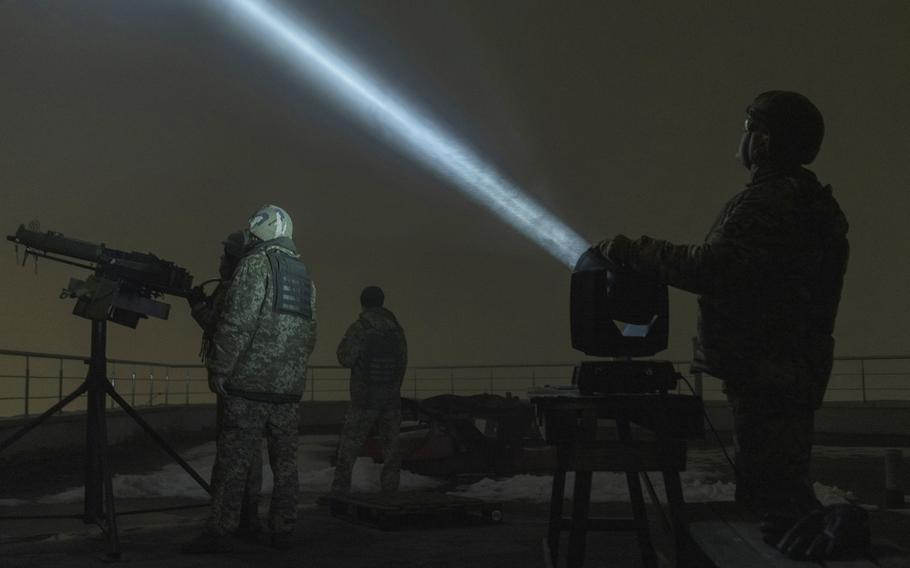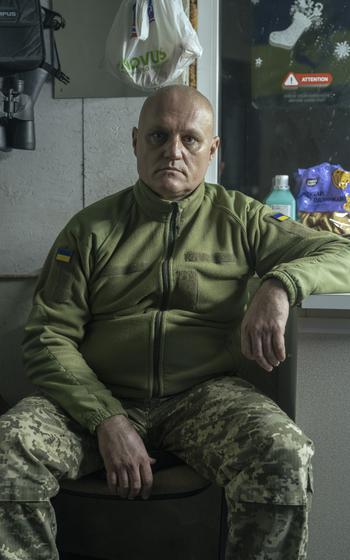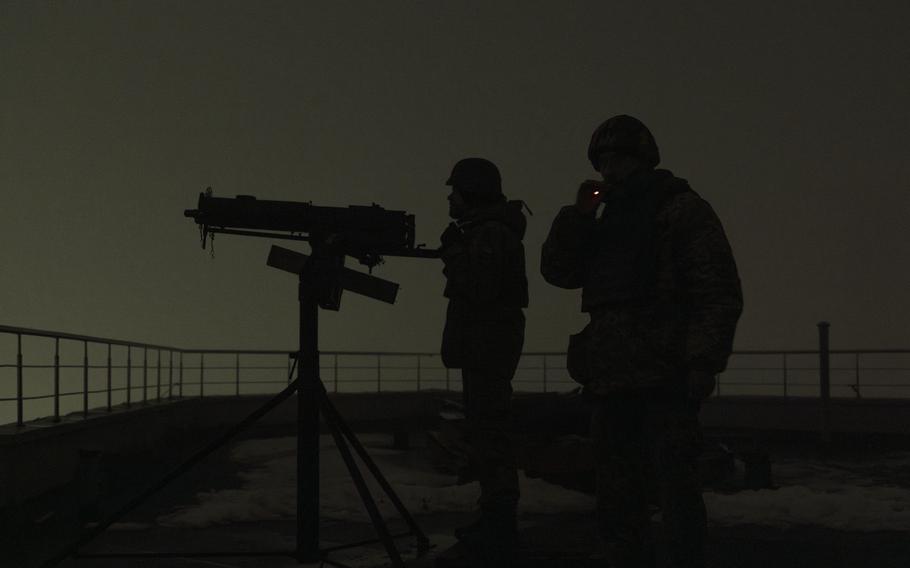Europe
Drones swarm Kyiv every night; these volunteers shoot them down
The Washington Post December 15, 2024

Mriya volunteers try to spot drones approaching Kyiv. MUST CREDIT: Sasha Maslov for The Washington Post (Sasha Maslov for The Washington Post)
KYIV, Ukraine — Nearly three years into Russia’s full-scale invasion of Ukraine, Kyiv is still using unpaid volunteers manning antiquated weapons to shoot down the daily swarms of drones targeting the capital, underscoring the government’s urgent requests to partners for new air defense systems.
In the past two months, Russia has dramatically ramped up its air assaults on Kyiv and other major cities, killing and wounding civilians and destroying energy infrastructure across the country. At least 165 civilians were killed and nearly 900 wounded in Ukraine in November, the United Nations reported. Ninety-three percent of those casualties occurred in Ukrainian-controlled territory.
Despite Russian threats to deploy nuclear-grade missiles against Ukraine, Moscow more often targets Ukraine with Iranian-designed drones called Shaheds. Use of these 11-foot-long winged drones that crash into their targets has nearly doubled since September: That month, Russia launched about 1,300 of them. By November, the count had reached 2,500.
The few U.S.-made Patriot missile air defense systems Ukraine has received are largely dedicated to shooting down more dangerous guided missiles. Shaheds, however, are small enough — and slow enough — that they can be taken down by machine guns.
This job often falls to civilian volunteers working several 12-hour shifts a week, manning guns at mobile and static air defense positions around the city. Many work regular jobs by day and shoot down drones by night.
Washington Post journalists embedded with one such unit from Ukraine’s Mriya volunteer formation for a 12-hour overnight shift in Kyiv starting at 9 p.m. on Dec. 1. That night, Russia launched 110 attack drones, including Shaheds. Ukrainian forces shot down 52. Another 50 were lost en route, which Ukraine’s Air Force attributed to its military’s successful disruption of their signals through electronic warfare.
By 8:30 the next morning, one Shahed was still circling over Ukraine.
It was just after 9 on a Sunday night, and maps on a Ukrainian military app showed a swarm of drones heading toward the capital.
Seven men in military uniforms, ranging in age from mid-30s to late 60s, huddled inside a small room on the roof of a high-rise building in Kyiv. They made coffee and tea and started cutting up a cake to eat as they awaited orders to man their World War II-era Maxim 7.62mm twin machine gun.
Below, they could feel the steady thump of music from a nearby nightclub.

Oleksandr Muzyka, 53, commander of a Mriya formation. (Sasha Maslov for The Washington Post)
“It’s like a feast in the time of cholera,” their commander, Oleksandr Muzyka, 53, said as he watched young men leave the club below their rooftop base.
Artem, a musician from the eastern city of Donetsk, monitored the drones on a tablet as they moved toward the capital.
“We are on high alert; drones are already in the Kyiv region,” he said. Then he pointed to the table: “We should eat the cake now, while it’s fresh.”
For two years, Mriya volunteers have used this location, which The Post agreed not to reveal because of concerns it would be targeted, as an air defense position to protect the city against Russian drones.
From the roof, the volunteers monitor the live military maps and then move to the gun outside if the air alert goes off. They scan the sky for drones with their searchlight and listen carefully for the distinctive hum. If it gets within their designated shooting zone, one volunteer mans the Maxim gun, and another feeds the bullets, like a scene from an old war movie.
At 9:41 p.m., the map showed a Shahed was approaching Ukraine’s long-shuttered international airport just outside of the capital. By 9:49, the air raid sirens were blaring.
The men rushed outside, fastening their helmets and removing a cover hiding the gun from view.
Two years ago, this rooftop was empty. Then Russia started launching Shaheds at Ukraine.
Serhii Sas, a former Constitutional Court judge who now serves as the commander of Mriya, saw one fly right over his head — and realized he might not need much more than a gun to shoot it down.
The military agreed to provide Sas’s volunteer unit with bullets and weapons, including the 1944 Maxim twin machine gun. The rest, the volunteers have bought themselves, such as the flak jackets, helmets, hand warmers, camouflage uniforms and food supplies — including the cake.

The military agreed to provide Sas’s volunteer unit with bullets and weapons, including a machine gun. (Sasha Maslov for The Washington Post)
In 2022 and 2023, the city of Kyiv provided bonuses to the unit’s volunteers of about $550 over two years. They have not been paid yet this year.
“We would like to see much more support, not so much in monetary terms but in technical assistance,” Sas said. “I believe this is within the capability of the Kyiv city government.”
The volunteers say they need more gear, such as thermal imagers, tablets, projectors and laser pointers. “These are not large expenses, really. But this is exactly what would improve the effectiveness of our work,” Sas said.
Roman Tkachuk, director of the security branch of Kyiv City Council, said bonuses are planned again for 2024. Material and technical support for such units, he wrote in a message, can be facilitated through territorial defense commanders.
Outside, the sound of gunfire echoed in the distance as other air defense positions fired at the drone. The Mriya volunteers stood on the ready — they could hear its hum nearby through the fog. But it never entered their firing zone.
When the siren shut off, they stepped back inside to warm up from temperatures hovering around freezing.
Then it blared again. And again. And again. The threats came and went all night long: air alert, increased air alert, all clear.
The men moved in and out, helmets off, helmets on. They took turns warming up inside, boiling water for tea, grabbing hand and foot warmers — and telling stories of how they get sick again and again from standing in the cold.
Around 12:30 a.m., Oleksii Tkachenko, 50, came inside for his break. He described how his wife, Anastasiia, and 4-year-old son, Mark, moved to Ireland to avoid these sleepless nights. “It’s better to live separately and eventually win than to live together under Russia.”
Like many in Ukraine, Tkachenko sees the nightly flocks of drones as a sign that Moscow lacks enough missiles to regularly strike its targets deep inside Ukraine. Instead, they stockpile them for occasional large-scale attacks. In the meantime, it relies on the cheaper drones to exhaust Ukraine’s air defense systems and provoke general anxiety among civilians.
Serhii Zamidra, 46, came in for his turn to warm up. The drones had split off to the west, and the next alert might come in 40 minutes, he said as he boiled more water for coffee.
At 1:10 a.m., explosions were reported in the western city of Ternopil. A Shahed had struck a residential building, killing one person and wounding several others.
The Shaheds often change course again and again, triggering air alarms in various regions of the country before they strike a target or are shot out of the sky. These attacks have helped Russia destabilize Ukraine’s energy system during the coldest and darkest days of the year, with recent strikes plunging some cities into days-long blackouts and forcing others, including Kyiv, to adapt to rolling power outages.
“Every time, the team must stay up all night like this,” Zamidra said. “Then go home and go to work.”
The near nightly assaults also terrify civilians, who wake up to sirens and rush to cold basements, corridors and train stations to take cover. Often, just after the alert is declared over, another wave of drones will trigger a new one, sending them scrambling for cover again.
At 1:39 a.m., the siren sounded again.
“It sometimes lasts the whole day,” volunteer Maksym Krutsevych, 49, said. “We feel it physically. We have to stay in all the gear. It takes a toll.”
At 2:37 a.m., after the air raid alarm had shut off, Ihor Bielski, 67, carried the light inside. Maybe the volunteers would now get a bit of rest.
Four hours later, the alarm was back on. The men stood by the gun as the sun rose over the city.
At 7:06 a.m., the air alert shut off. The shift was almost over.
Some would go home to rest; others would go home to shower and head to work. At least one would come back that night. Others would return to the cold rooftop in the coming days.
Zamidra sometimes gets home in time to drop his 4-year-old daughter off at kindergarten on his way to work.
The air raid alerts he monitors all night, he said, have turned into a game for Ukrainian children.
“They sit in the sandbox, and then someone shouts, ‘Air raid!’” he said. “They start running around the playground, hiding, playing tag — just like we used to play back in the day.
“But for them, the game now is air raid alerts, unfortunately.”

Mriya volunteers with a machine gun on a rooftop. MUST CREDIT: Sasha Maslov for The Washington Post (Sasha Maslov for The Washington Post)